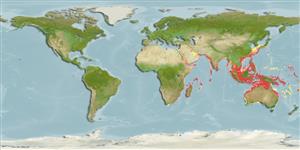Preferred temperature (Réf.
123201): 23.7 - 28.3, mean 27.3 °C (based on 491 cells).
Phylogenetic diversity index (Réf.
82804): PD
50 = 0.6250 [Uniqueness, from 0.5 = low to 2.0 = high].
Bayesian length-weight: a=0.00871 (0.00769 - 0.00987), b=3.07 (3.04 - 3.10), in cm total length, based on LWR estimates for this species (Ref.
93245).
Niveau trophique (Réf.
69278): 3.3 ±0.38 se; based on food items.
Generation time: 1.1 (0.9 - 1.2) years. Estimated as median ln(3)/K based on 81
growth studies.
Résilience (Réf.
120179): Milieu, temps minimum de doublement de population : 1,4 à 4,4 années (K=0.2-1.9; tm=0.5-1; tmax=4; Fec = 37,690).
Prior r = 0.62, 95% CL = 0.41 - 0.93, Based on 1 full stock assessment.
Fishing Vulnerability (Ref.
59153): Low vulnerability (17 of 100).
🛈
Climate Vulnerability (Ref.
125649): Moderate to high vulnerability (52 of 100).
🛈
Nutrients (Ref.
124155): Calcium = 200 [75, 539] mg/100g; Iron = 3.28 [1.58, 6.56] mg/100g; Protein = 20.6 [19.4, 21.9] %; Omega3 = 0.32 [0.15, 0.67] g/100g; Selenium = 47.6 [16.2, 153.7] μg/100g; VitaminA = 22.8 [6.0, 89.3] μg/100g; Zinc = 1.24 [0.67, 3.18] mg/100g (wet weight); based on
nutrient studies. 